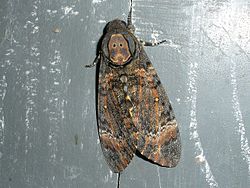- Acherontia styx
-
Acherontia styx

Acherontia styx, adultaClasificación científica Reino: Animalia Filo: Arthropoda Clase: Insecta Orden: Lepidoptera Familia: Sphingidae Género: Acherontia Especie: A. styx Nombre binomial Acherontia styx
Westwood, 1847Sinonimia - Acherontia ariel Boisduval, 1875
- Acherontia pseudatropos Röber, 1933
- Acherontia styx interrupta Closs, 1911
- Acherontia styx obsoleta Schmidt, 1914
- Acherontia styx crathis Rothschild & Jordan, 1903
- Acherontia styx septentrionalis-chinensis Pavlov, 1932
Acherontia styx es una mariposa nocturna de la familia Sphingidae oriunda de Asia. Tiene una preferencia particular por la miel y los apicultores han reportado haber encontrado individuos de esta especie dentro de las colmenas. La acherontia styx tiene la propiedad de imitar el aroma producido por las abejas, lo cual le permite entrar en una colmena sin ser atacada para conseguir miel. Su lengua, la cual es robusta y fuerte, le permite extraer miel al introducirse entre las paredes de las celdas. También se les conoce por infestar las plantaciones de yuzu (Citrus junos) en Corea del sur.
Esta especie es similar a la europea A. atropos pero se diferencia por tener dos bandas a la mitad inferior de las alas delanteras en vez de una y usualmente no tiene ninguna banda oscura a través de la superfice ventral del abdomen. La mancha en forma de calavera es una The skull-like marking is darker and there is a faint blue tornal dot enclosed by a black submarginal band on the hindwing upperside. The forewing discal spot (stigma) is orange; in A. atropos it is usually white.[1]
There are two described subspecies, A. s. styx, and A. s. medusa Moore, but they intergrade widely, and authorities presently consider that A. s. medusa is just a wet zone/season form, and not taxonomically distinct.[1]
Contenido
Development
Eggs are laid primarily on Bignoniaceae, Fabaceae, Oleaceae, Pedaliaceae, Solanaceae and Verbenaceae. In India, the larvae sometimes occur in such numbers as to cause serious damage to crops, such as Sesamum indicum. Mature larvae can attain 120mm, and come in green, yellow, or brown color forms. Larvae closely resemble those of A. atropos except that the dark blue dorsal speckling is more pronounced on the anterior half of each abdominal segment, and the tail horn is less curved and lacks a reflexed tip. Pupation occurs in an underground chamber, excavated less than 10cm below the surface of the soil.
Distribution
The variant referred to as A. styx medusa occurs throughout eastern continental Asia, from northeastern China (to where it is a migrant) and Japan, south through eastern China and Vietnam to Peninsular Malaysia and peninsular Thailand. Also found throughout the islands of the Malay Archipelago. A. s. styx occurs from north-central and western China westward across northern Thailand, Myanmar, Bangladesh, India, Nepal, Pakistan and Iran to Saudi Arabia and Iraq.[1]
Popular culture
An Acherontia styx pupa found in the soft palate of a murder victim is a vital clue in the thriller novel The Silence of the Lambs. In the movie version, however, while the script still refers to styx, the species depicted is Acherontia atropos.
References
 Wikimedia Commons alberga contenido multimedia sobre Acherontia styxCommons.
Wikimedia Commons alberga contenido multimedia sobre Acherontia styxCommons.
Categorías:- Wikipedia:Traducciones en desarrollo en otros idiomas
- Acherontiini
Wikimedia foundation. 2010.

